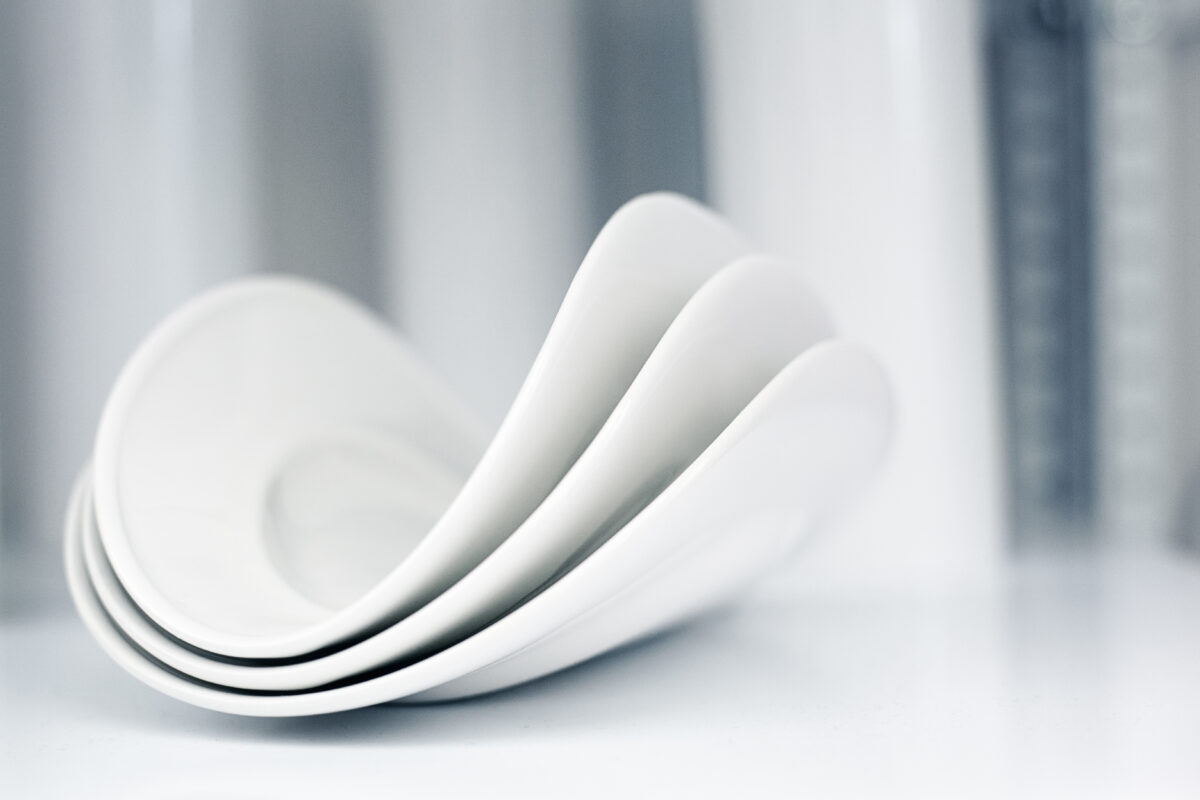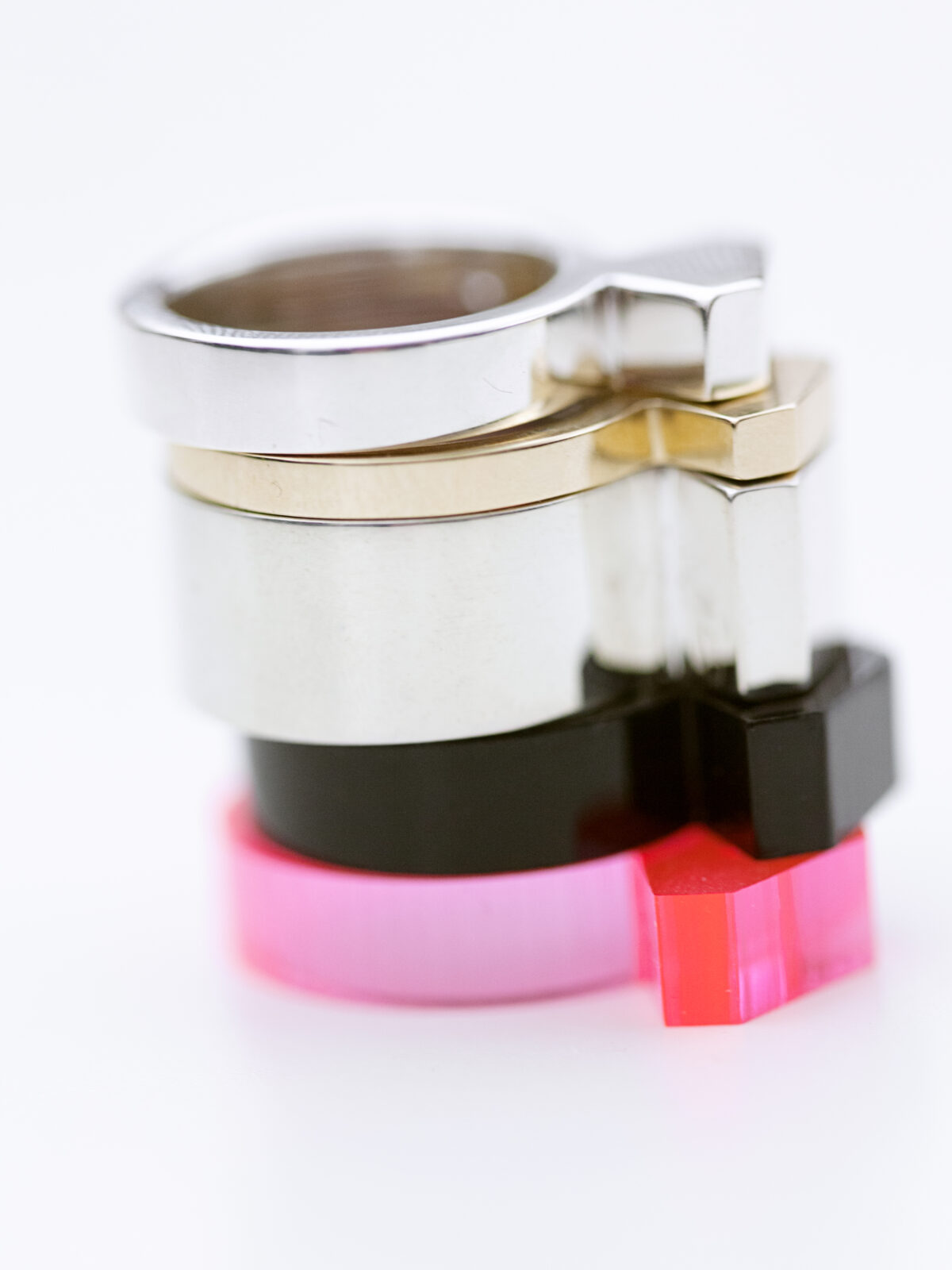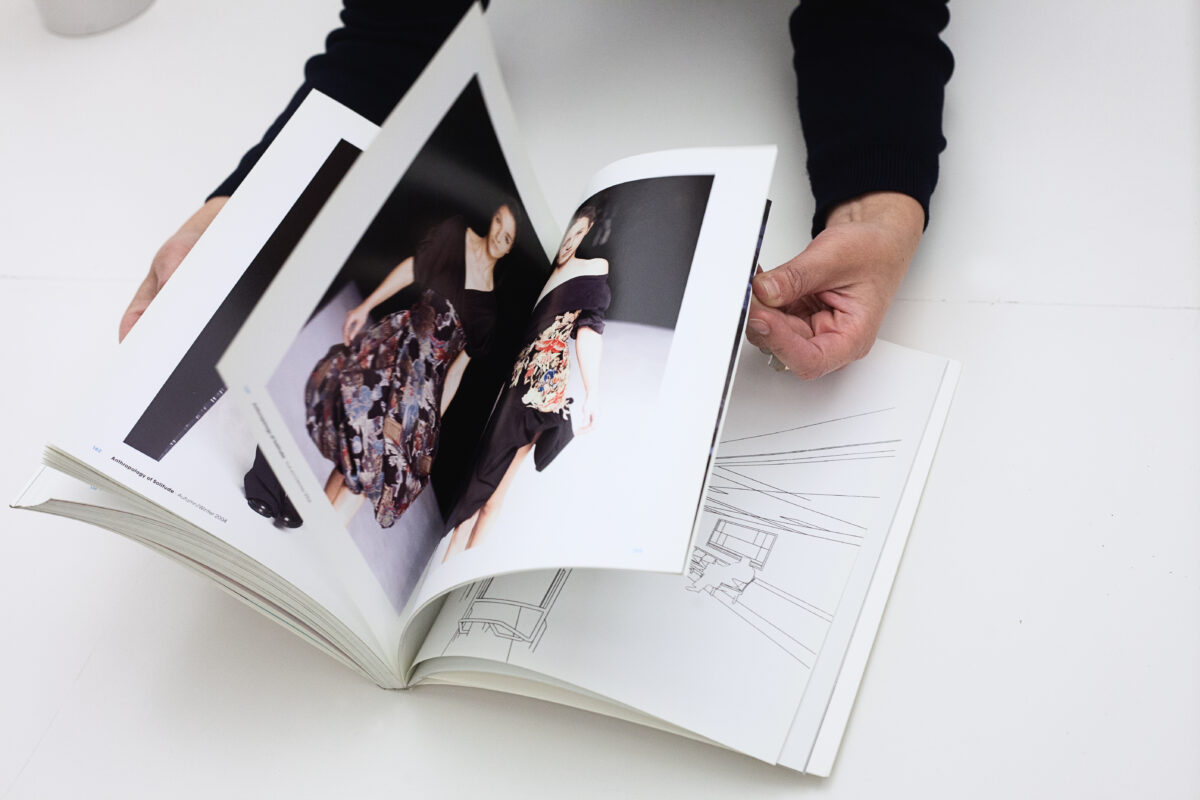“I often ask myself,” says Alissia Melka-Teichroew, “Does the world need more stuff?” The question comes after a walk-through of the designer’s lower Manhattan studio, where vestiges of her 16-year career abound.
Curved ceramic plates, completed while still a student at the Design Academy Eindhoven; the inventive InsideOut glasses designed for German company Charles & Marie; the diamond acrylic rings in kaleidoscopic colors, her first project produced in the US. She regards each with a smile, and—always—a story.
Alissia, the daughter of a French mother and an American father, grew up in The Netherlands, landing briefly thereafter in Paris, San Francisco, Rhode Island and Boston. She’s now based in the Big Apple, a city that’s home to byAMT, a studio and creative consultancy that’s drawn clients including AREAWARE, Van Esch and Kikkerland (a neighboring brand for whom Alissia has art directed and styled a selection of lookbooks).
Recently, it was announced that the studio would no longer produce its designs in-house, a notable shift after over a decade of steady production. It is time for new things, new adventures, read the notice on the website—a fitting sentiment from a designer who speaks openly about not taking oneself too seriously, and the ever-changing nature of what we find inspiring, challenging and new.
“When you’re surrounded by things you love, it puts you in a happier place,” Alissia says, perhaps answering her own question about the quantity of “stuff” in the world. “It makes your life more fun.” What, she wonders, could be more important?
Alissia designed the gorgeous grid cup, saucer & spoon for the forward-thinking brand, OTHR. This portrait is part of our ongoing collaboration with OTHR, as we profile their international roster of designers. Visit OTHR for more on this story and see the beautiful designs they’ve curated.


“When it comes to design, I’m more excited about the process than I am about the outcome.”
-
To start, have you always been a maker? Was the journey to becoming a designer one that started early?
Nope, not really. Initially I went down an academic path. I went to university in Utrecht and met a guy whose best friend went to the Design Academy Eindhoven. I visited and I was surprised—it had a name that made it sound like it was more of an engineering school. But then I found out it wasn’t, and I thought, wait a minute. I applied, totally randomly, thinking there was no way I was going to get in. I didn’t have any background in design, and they accepted only 70 people out of 1,200. But I got accepted. The whole thing was a surprise to me. My parents were also very surprised—they were like, “She’s working! She’s actually working on weekends. What happened?”
-
When was it that things really clicked for you? Can you identify that moment?
Once I’d made it through the first year-and-a-half or so, that’s when things sort of landed a bit more. I was really appreciating it and I wasn’t thinking of anything else. It was when I began to feel truly comfortable but also continuously challenged, if that makes sense.
-
Can you remember the first thing you created that excited you?
When it comes to design, I’m more excited about the process than I am about the outcome. When a concept or a story that you have comes together with the details, the material, the finish—when everything falls into place, I’m happy. After that, I kind of don’t know what to do. I think, ‘next!’ But that’s not how real life works.







-
One of your most popular items is the Diamond Ring. Was it a love of jewelry that inspired that piece?
No. I don’t wear a lot of jewelry. But I’m interested in jewelry as object. I took a Jewelry 101 class at RISD because I was interested in learning about metal work. It was for fun, but I told myself that every time I learned a technique, I’d design something new. It was a six-week class, so I thought of it as a six-week design workshop with myself. The ring was one of the things I made. I was thinking, what’s the meaning of a diamond ring? I made it in acrylic, so that anyone could buy it—you could buy as many as you want. That was the first product I produced in the US. And it’s the one that really took off.
-
How long have you lived in New York?
I moved with the rings, so since 2005. I was born and raised in The Netherlands, attended grad school at RISD, moved to San Francisco, and then to New York on a whim. My relationship with the city is love and hate. Everyone has that in New York a little bit. But in the US, it’s the only place I’d live.
-
How have you seen the design industry evolve since you arrived?
Things in the design world are changing a lot. It’s an interesting time. When I got here in 2002, design as we know it now was seen as functional art. I didn’t look at it that way, because I was coming from The Netherlands and that’s not how we think about it there—it’s just design, and its function is to make our lives better and more enjoyable because we love what we’re surrounded by. Both aesthetics and function are of importance. Now, I think people are really seeing design for what it is. They’re appreciating color, material. You don’t have to make everything in the millions or tens of thousands for it to be viewed as valuable. A lot has changed in a very short time.







“Finding new ways to push myself past my comfort zone and into new territory isn’t something that follows any particular formula. It changes all the time.”
-
What’s an example of another of your pieces that’s been interpreted in a surprising way?
The Little Big Trivet. Kids love to wear it like jewelry. They put it around their neck or they wear it as a purse. My former bookkeeper’s boyfriend was so in love with it that he hung it on his front doorknob just so he could always see it.
Also, the diamond ring has been interpreted in many ways. I’ve heard everything from very sad stories to the happiest stories. What I like about that product, even though it’s not my favorite, is the way people have reacted to it. Some people view it as something serious—like an engagement ring—and some don’t, and the difference between the two is very big. To some, it’s a really good joke. Others are like, “I’ve been looking for a ring like this forever.” I like that a lot. That piece was meant for that dialogue.
-
Which artists or creative thinkers do you especially admire, in a design field or otherwise?
I love Hussein Chalayan, the fashion designer. His older work was so provocative. He’s from Cyprus, and because of the political conflicts there, he made a clothing collection based on the concept of refugees—essentially, when you flee, what can you take? Most often, it’s not furniture or other beloved items. So the garments were a part of the furniture. The chairs became suitcases. The table was a skirt.
-
You mentioned earlier that you felt truly connected with design once it became a comfortable practice for you, but also a consistently challenging one. How do you find balance between those two things in your work today?
Right now, I’m doing that mostly by choosing to move to the next phase of no longer producing things in-house. Finishing that phase of my career completely is a weight off my shoulders, but it’s also difficult, because it requires me to completely change the way I’ve been working for the past 11 years. That, in itself, is a challenge. But it’s a good one. Overall, finding new ways to push myself past my comfort zone and into new territory isn’t something that follows any particular formula. It changes all the time.





Selected Works by Alissia
“I like looking around for no reason at all. It keeps me interested in what’s around me.”
-
What other creative pursuits do you enjoy apart from design?
I’ve always liked photography, and now, I love Instagram. I’m a little addicted. It’s become a visual exercise for me, to keep looking around, to find something to post about every day.
-
What in particular catches your eye? Is there a common thread that links the images you capture?
That differs every day. And of course, Instagram functions in different ways. My feed is a mix of work-related pictures that I think I should post and other things that catch my eye during the day. Some days it’s more of a tool than it is on others—I guess it depends on what I’m working on at the time. Sometimes you’re in the middle of a project and you need ideas, so you’re actively looking. Other times, you don’t need ideas at all but then you see something and there is one. It’s pretty haphazard. In general, I like looking around for no reason at all. It keeps me interested in what’s around me.
-
Lastly, you’re a very happy presence—someone who laughs a lot. Would you say humor has been a big part of your life?
Humor is an important part of my work, and an important part, in general, of life. There’s too little of it in this country. People take things too personally. In design school, that’s especially true. If you offer someone criticism, it’s like you’re telling them, “You’re fucking fat.” But really, it’s just about telling someone that their work isn’t portraying what they want it to, or that the choices they’ve made may not be the right ones. Outside of school, sometimes a client doesn’t want something and you might not agree. But in our work, it’s important not to take things too personally—or to try not to.




Thanks, Alissia for showing us your beautiful studio. Learn more about byAMT, here and check out the inspiring designs by OTHR, who utilize 3D-Printing to create their unique objects by demand.
Visit our archive to meet more inspiring personalities from New York.
Text:Shoko Wanger
Photography:James Chororos







